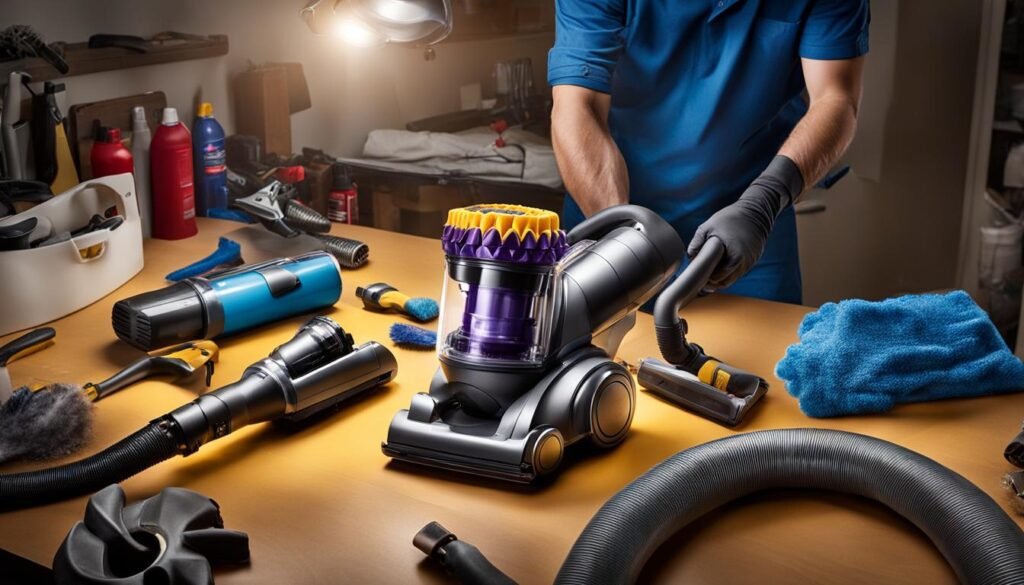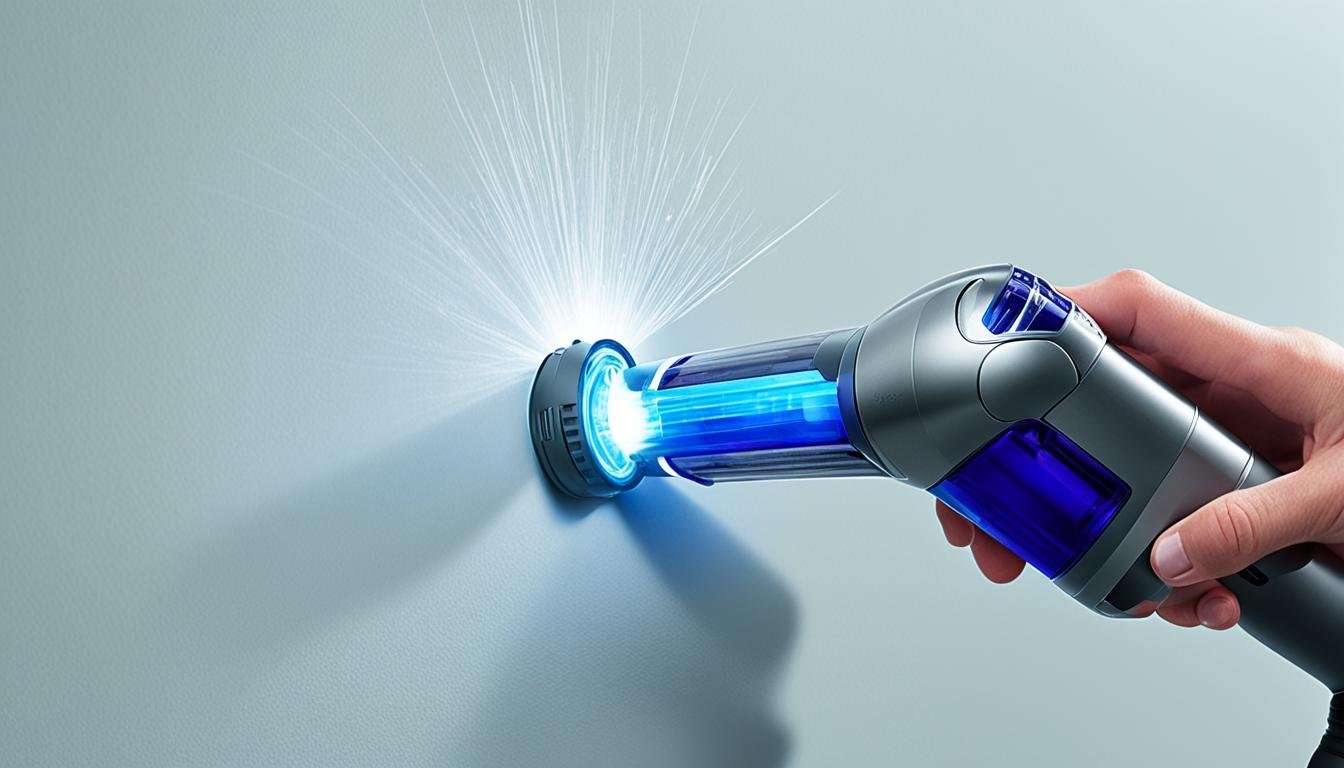If you’re experiencing a loss of suction with your Dyson DC33 vacuum cleaner, I’m here to help you troubleshoot and fix the issue. There could be several reasons for the reduced suction power, but don’t worry, we’ll go through each one step by step.
The first thing to check is the filters. The Dyson DC33 has both pre-motor and post-motor filters which can get clogged with dirt and dust over time, affecting the suction. Cleaning or replacing these filters can often do the trick.
Another potential problem could be a blockage in the hose or ducting of the vacuum. Any tears or blockages in these areas can hinder the airflow, leading to decreased suction. Checking for and clearing any obstructions will help restore the vacuum’s performance.
The brush roll not spinning can also give the impression of reduced suction. This could be caused by a broken belt. If that’s the case, you’ll need to replace the belt to get it working properly again.
If none of these troubleshooting steps solve the issue, it might be a problem with the motor itself, and it will need to be replaced. However, this is less common and usually only necessary in severe cases.
Remember, regular maintenance is key to keeping your Dyson DC33 in top shape. Cleaning or replacing filters, checking for blockages, and ensuring proper height adjustment will help prevent these issues from occurring in the first place.
Key Takeaways:
- Loss of suction can be caused by clogged filters, so cleaning or replacing them is essential.
- Check for blockages in the hose and ducting, and clear any obstructions if necessary.
- A broken belt can cause the brush roll to stop spinning, giving the impression of reduced suction.
- If troubleshooting steps don’t work, it may be a problem with the motor and it will need to be replaced.
- Regular maintenance, such as cleaning or replacing filters, can help prevent these issues from occurring.
How to Clean and Replace Filters on the Dyson DC33
The Dyson DC33 vacuum cleaner is a powerful and reliable cleaning tool. To ensure optimal performance, regular maintenance is essential. One crucial aspect of maintaining your Dyson DC33 is cleaning and replacing the filters. Over time, these filters can become clogged with dirt and dust, causing a reduction in suction power. In this section, I will guide you through the process of cleaning and replacing the filters on your Dyson DC33, keeping it in top shape for efficient cleaning.
Cleaning the Pre-Motor Filter
The Dyson DC33 has two filters – a pre-motor filter and a post-motor filter. Let’s start with the pre-motor filter:
- Turn off and unplug your Dyson DC33.
- Locate the pre-motor filter. It is usually located inside the dustbin compartment.
- Remove the pre-motor filter carefully from its housing.
- Rinse the filter under cold water to remove any dirt and debris.
- Gently squeeze out any excess water and allow the filter to air dry completely.
- Once the pre-motor filter is dry, reinsert it into its housing.
Cleaning the Post-Motor Filter
Now, let’s move on to cleaning the post-motor filter:
- Locate the post-motor filter. It is usually located at the back of the vacuum cleaner.
- Remove the filter from its housing.
- Follow the same steps as cleaning the pre-motor filter: rinse it under cold water, squeeze out excess water, and allow it to air dry completely.
- Once the post-motor filter is dry, reinsert it into its housing.
Regularly checking and cleaning the pre-motor and post-motor filters is crucial to maintain the suction power and overall performance of your Dyson DC33. However, if the filters remain dirty even after cleaning, it may be time to replace them.
Replacing the Filters
If your filters are worn out or damaged, it’s important to replace them with new ones. This ensures maximum suction power and keeps your Dyson DC33 running efficiently. To replace the filters, follow these steps:
- Purchase compatible replacement filters for your Dyson DC33. Genuine Dyson filters are recommended for optimal performance.
- Turn off and unplug your Dyson DC33.
- Remove the old filters from their respective housings.
- Insert the new filters into their designated housing compartments.
- Ensure that the filters are securely in place before moving onto the next cleaning task.
By regularly cleaning and replacing the filters on your Dyson DC33 vacuum cleaner, you can maintain its optimal performance, prolong its lifespan, and enjoy efficient cleaning power.
Now that you know how to clean and replace the filters on your Dyson DC33, you can ensure the best possible cleaning experience. In the next section, we will explore troubleshooting hose and ducting issues on the Dyson DC33 to address another common problem encountered by users.
Troubleshooting Hose and Ducting Issues on the Dyson DC33
If you’re experiencing a loss of suction with your Dyson DC33 vacuum cleaner, one of the potential causes could be blockages or tears in the hose and ducting. To address this issue, follow these troubleshooting steps:
- Detach the wand and remove the hose: First, detach the wand from the vacuum and remove the hose from the machine. This will allow you to access and inspect the hose more effectively.
- Check for blockages or tears: Carefully examine the hose for any visible blockages or tears. These obstructions can obstruct the suction power of the vacuum. If you spot any, use your fingers or a long, flexible object like a coat hanger to remove the blockages or repair the tears.
- Inspect the internal hose: Apart from the visible hose, the Dyson DC33 also has an internal hose located underneath the vacuum. Check this hose for any blockages or damage as well. Clear any debris or foreign objects that might impede the airflow.
- Examine the ducting: In addition to the hose, inspect the various ducting components, such as the u-bend and other pieces, for potential obstructions. Any blockages in the ducting can hinder the proper functioning of the vacuum. Remove any debris or blockages you find.
By clearing any blockages or tears in the hose and ducting, you can restore the suction power of your Dyson DC33 vacuum cleaner and ensure optimal performance.
Remember, regular maintenance and troubleshooting are essential to keep your Dyson DC33 running smoothly and efficiently.

Conclusion
The Dyson DC33 is a powerful and durable vacuum cleaner that can tackle even the toughest cleaning tasks. However, like any appliance, it may encounter some common issues that can affect its performance. If you find that your Dyson DC33 is not working as it should, don’t worry. There are several troubleshooting tips you can follow to resolve these problems and get your vacuum back to optimal performance.
One of the most common issues with the Dyson DC33 is a loss of suction. This can often be attributed to clogged filters or blockages in the hose and ducting. By regularly cleaning or replacing the filters, you can ensure that your vacuum maintains its suction power. Additionally, checking for blockages in the hose and ducting and clearing them if necessary can help restore the performance of your Dyson DC33.
Another common problem with the Dyson DC33 is the brush bar not spinning. This can be caused by a broken belt or a blockage in the brush roll area. By inspecting the brush roll and ensuring that it is free from obstructions, you can get the brush bar spinning again and improve the overall cleaning performance of your Dyson DC33.
In conclusion, while the Dyson DC33 may encounter some issues, they can usually be addressed with the right troubleshooting steps. By following the maintenance tips mentioned in this article, you can prevent these problems from occurring and keep your Dyson DC33 functioning at its best. Remember, if all else fails, it may be necessary to replace the motor or seek professional assistance. Taking proper care of your Dyson DC33 will ensure its longevity and continued performance.
FAQ
Why is my Dyson DC33 vacuum cleaner losing suction?
There are several possible reasons for a loss of suction on the Dyson DC33. The filters may be clogged with dirt and dust, hindering the suction power. Check and clean or replace the pre-motor and post-motor filters. Another potential issue could be a blockage in the hose or ducting. Inspect these areas for blockages or tears. Additionally, a broken belt can cause the brush roll to stop spinning, giving the impression of reduced suction. Finally, if none of these troubleshooting steps work, it may be a problem with the motor that needs to be replaced.
How do I clean and replace the filters on the Dyson DC33?
The Dyson DC33 has two filters – a pre-motor and a post-motor filter. To clean the pre-motor filter, remove it from the vacuum and wash it under cold water. Squeeze out excess moisture before reinstalling. The post-motor filter can also be cleaned in the same way. If the filters remain dirty after cleaning, consider replacing them with new ones. Regularly checking and cleaning or replacing the filters can help maintain optimal performance.
What should I do if there are blockages in the hose and ducting of my Dyson DC33?
If you notice a loss of suction, check the hose and ducting for blockages or tears. Detach the wand from the vacuum to access the hose, and remove it from the machine. Inspect for any visible blockages or tears and remove them if necessary. Similarly, check the internal hose underneath the vacuum for any blockages or damage. Additionally, inspect the ducting, such as the u-bend and other pieces, for obstructions. Clearing any blockages from the hose and ducting can help restore suction to your Dyson DC33.
What should I do if my Dyson DC33 is not working?
If you’re experiencing issues with your Dyson DC33, such as loss of suction or the brush bar not spinning, try the troubleshooting tips mentioned above. Regular maintenance, like cleaning or replacing filters, checking for hose and ducting blockages, and ensuring proper height adjustment, can help prevent these problems. If all else fails, it may be necessary to replace the motor or seek professional assistance. Taking care of your Dyson DC33 will ensure its longevity and optimal performance.





Leave a Reply